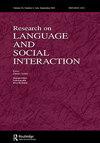用语言描述事物时的指示困难:日语对话中“Koo”在词搜索中的应用
IF 2.1
1区 文学
Q1 COMMUNICATION
引用次数: 1
摘要
摘要本研究探讨了日语对话中词汇犹豫者koo在启动或继续词语搜索中的作用。“koo”(“像这样”,“以这种方式”)一词通常用作方式的近端指示副词,通常伴随着描绘手势。我们认为,由于其与规范用法的连续性,犹豫者koo (a)将描述性术语作为可能的搜索结果,并且(b)表明难以用语言描述说话者想说的话。除了发起或继续搜索之外,犹豫者koo还提供了有关搜索解决的类型和性质的信息,从而增强了搜索过程的主体间性。本研究通过确定一种特定的语言资源的功能,有助于我们理解自我发起的同转修复的组织。资料为日文,附有英文翻译。本文章由计算机程序翻译,如有差异,请以英文原文为准。
Indicating Difficulty in Describing Something in Words: The Use of Koo in Word Searches in Japanese Talk-in-Interaction
ABSTRACT This study explores how the lexical hesitator koo is used to initiate or continue word searches in Japanese talk-in-interaction. The word koo (“like this,” “in this manner”) is canonically used as a proximal demonstrative adverb of manner, often accompanied by a depicting gesture. We argue that because of its continuity with the canonical use, the hesitator koo (a) projects a descriptive term as a possible search outcome, and (b) indicates difficulty in describing in words what the speaker wants to say. In addition to initiating or continuing a search, the hesitator koo provides information about the type and nature of the resolution of search, thereby enhancing the intersubjectivity of the search process. This study contributes to our understanding of the organization of self-initiated same-turn repair by identifying the function of a particular lingistic resource used for it. Data are in Japanese with English translation.
求助全文
通过发布文献求助,成功后即可免费获取论文全文。
去求助
来源期刊
CiteScore
7.30
自引率
7.40%
发文量
20
期刊介绍:
The journal publishes the highest quality empirical and theoretical research bearing on language as it is used in interaction. Researchers in communication, discourse analysis, conversation analysis, linguistic anthropology and ethnography are likely to be the most active contributors, but we welcome submission of articles from the broad range of interaction researchers. Published papers will normally involve the close analysis of naturally-occurring interaction. The journal is also open to theoretical essays, and to quantitative studies where these are tied closely to the results of naturalistic observation.

 求助内容:
求助内容: 应助结果提醒方式:
应助结果提醒方式:


